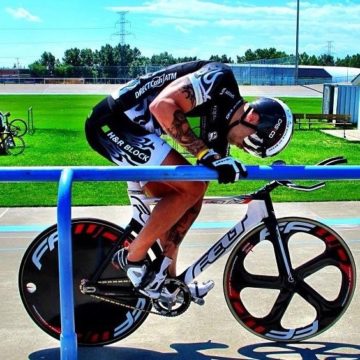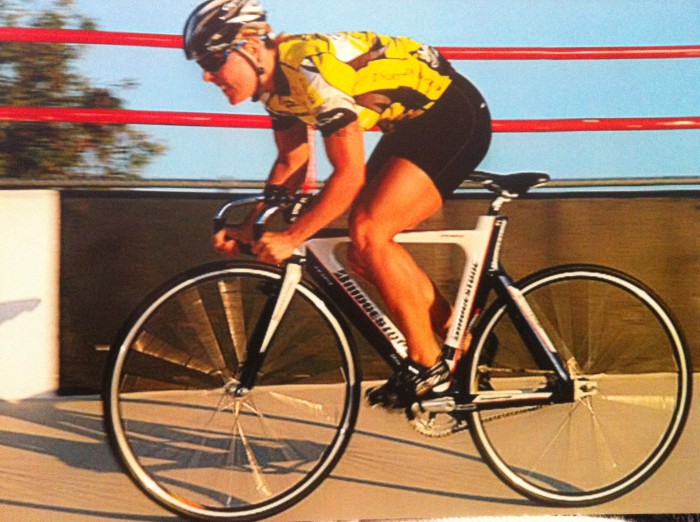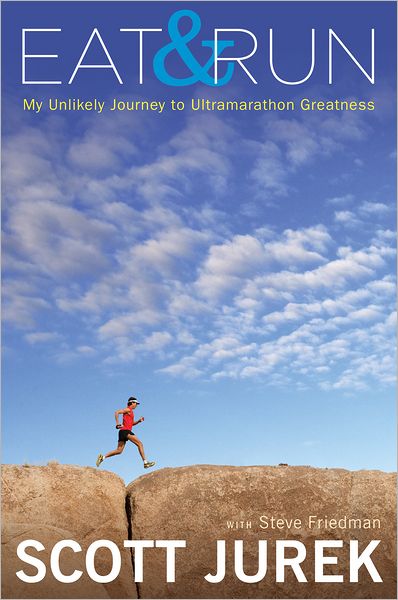What is it that makes some of us push ourselves to the breaking point? To spend our time, most of our disposable income, risk our relationships, risk injury and failure. What does it take when there is the guarantee of no red carpet, no cash prize, no Olympic medal, nothing tangible – just a quiet whisper of “I did it,” as payoff. That is the reality for a growing sector of what is being called recreational elite athletes.
I just got home from a weekend in Los Angeles, 3 days of eating vegan junk food and basking in the post meal gluttony of The Veggie Grill, watching my partner participate at the StubHub Velodrome. At this training camp hosted by a former World Champion cyclist and current coach for the US Olympic Team, 9 men and 1 woman paid the high price tag to come and learn from the best. Most of them will be heading to Manchester, England in October to pit themselves against the best amateur track cyclists from around the world at the World Master ‘s Championships.
As far as expensive sports go, track cycling might be one of the highest. A simple bike frame and disc wheels can set you back $8,000 without handle-bars, gears, helmet, shoes, seat, or kit. The expensive set ups can pass well beyond the $20,000.00 mark. Then include paying for track time, coaching, travel expenses, race entries and repairs – and you start to question your sanity.
I had never seen a real indoor wooden track. In Canada we tend to spend more of our recreational tax dollars on hockey arenas, so the indoor velodromes–with 43 degree pitch hardwood track and proper stands, UCI officials and Olympic hopefuls–were impressive to say the least. As I sat in the stands watching the riders completing warm up laps behind a motorbike (they can easily get up to speeds exceeding 75km an hour) I started to wonder about what drove these men – and one woman – to put themselves through this. Their faces awash in almost grief, hands white knuckling handle bars, ragged breaths, legs going past exhaustion pumping on pure adrenalin. Giving their absolute everything to pass each other. Doing it over and over and over again, close calls, sweat, blood – exploding tires and disheartening times. How did they get here?
Steve Shiers, a fellow plant-based athlete, and a personal trainer and coach by profession, is training towards what he hopes to be a multi-year “career” on the track. Based out of Calgary, Canada, Steve has no choice but to take his bike and his training to LA if he expects to be competitive in the amateur circuit. Operating his business and having a family can make balance difficult; Steve’s wife and son have joined him this trip, and after 3 hours of intense sprinting behind a motorbike, Steve forgoes the post training pleasantries, and rushes off to take his son to Disneyland for the afternoon. I asked Steve why he pushes himself so hard when there is no tangible payoff. “To me life is about the best you can be, constantly redefining yourself, pushing past your limits, proving to yourself that it can be done, regardless of what others say. These are things I can control and the things only I can achieve. This is something that money cannot buy, nor can it fill the void of ever giving up and accepting failure.”
A San Francisco cop, a lawyer from Texas, and a Hollywood Hills socialite in a hurry to get home on a Sunday morning because his childcare is up at noon. A heart surgery patient one year after a valve replacement, and a yoga teacher, a band of outliers chasing down or being chased by life’s demons.
My partner is a 5-time National gold medal Champion with a professional cycling career under her belt. Last year she decided to dust off her gear and get back on her bike after hanging up her wheels 6 years ago. This time around there are no big corporate sponsorships, no Olympic bid – just her and her wheels and the wood of the track, the pitch of the banked turns and the clock. When I posed the same question to her, she said, “It’s being on the top of the track, parallel to the floor, wind whistling past my ears, going 60km, teetering on the edge of control. The smell of the wood, the tires, my legs on fire, eyes starting to black out from the strain, hands numb. I gave that up and thought I could live without it, but I need that, I need to be on the edge. It is a huge financial sacrifice for me to be here. I’ve given up a lot to this sport and the payoffs are intangible, but don’t think they aren’t there.”
As technology advances we are creating a world with more idle time, more conveniences and less physical hardships and what is left is a hole that is filled for some only when pushing the envelope. Maybe a thousand years in the past these 9 men and 1 woman might have been the strongest and fastest hunters gatherers or leaders of their cave dwelling tribal community. It certainly seems like they are tapped into something primal, something on a cellular level that drives them to go further, faster and harder than the rest of us.
More by Misti: Life Lessons from Ultra Athletes
Dispatch: Notes from Ethiopia, the Land of Sun, Injera, and Running
Photo: Misti Sayani




